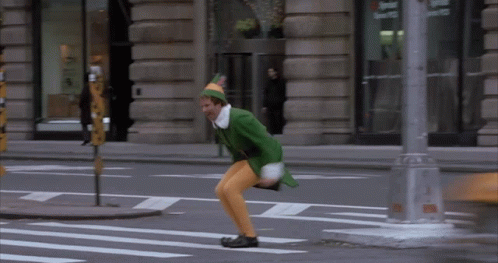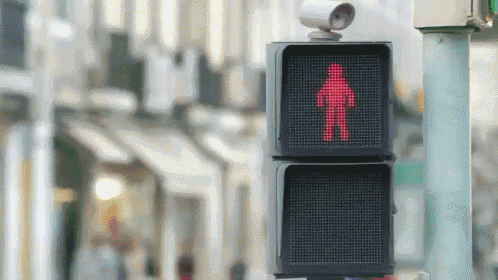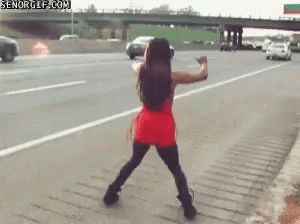Cross at Intersections and Designated Crosswalks.
A pedestrian is someone on foot or who uses a means of travel such as roller skates, skateboard, or wheelchair. We have previously discussed the rights of pedestrians briefly in this course. In this lesson, we will further examine the role of pedestrians as it relates to motor vehicle drivers. More specifically, we will look at the rules that pedestrians must obey.


Pedestrian Control Signals and Crossing Between Controlled Intersections:
Pedestrians are not allowed to enter the roadway at any place except in a crosswalk when crossing between adjacent intersections controlled by a traffic signal or by police officers. (CVC 21955)
If a pedestrian control signal showing the words “WALK” or “WAIT” or “DON’T WALK” or other approved symbol is in place, the signal shall indicate as follows:
(a) A “WALK” or approved “Walking Person” symbol means a pedestrian facing the signal may proceed across the roadway in the direction of the signal but shall yield the right-of-way to vehicles lawfully within the intersection at the time that signal is first shown.
(b) A flashing “DON’T WALK” or “WAIT” or approved “Upraised Hand” symbol with a “countdown” signal indicating the time remaining for a pedestrian to cross the roadway means a pedestrian facing the signal may start to cross the roadway in the direction of the signal but must complete the crossing prior to the display of the steady “DON’T WALK” or “WAIT” or approved “Upraised Hand” symbol when the “countdown” ends.
(c) A steady “DON’T WALK” or “WAIT” or approved “Upraised Hand” symbol or a flashing “DON’T WALK” or “WAIT” or approved “Upraised Hand” without a “countdown” signal indicating the time remaining for a pedestrian to cross the roadway means a pedestrian facing the signal shall not start to cross the roadway in the direction of the signal, but any pedestrian who started the crossing during the display of the “WALK” or approved “Walking Person” symbol and who has partially completed crossing shall proceed to a sidewalk or safety zone or otherwise leave the roadway while the steady “WAIT” or “DON’T WALK” or approved “Upraised Hand” symbol is showing.
(Amended by Stats. 2017, Ch. 402, Sec. 1. (AB 390) Effective January 1, 2018.)

Pedestrian on Roadway
Pedestrians must walk on certain sides of the roadway when there is no sidewalk present. Pedestrians may only walk close to his or her left-hand edge of the roadway when walking on a roadway outside of a business or residence district.
Additionally, pedestrians may only walk close to his or her right-hand side of the roadway if a crosswalk or other means of safely crossing is not available. They may also cross on the right-hand side if other conditions would compromise their safety in attempting to cross the road. (CVC 21956)

Blind Pedestrians
A totally or partially blind pedestrian who is carrying a white cane with a red tip or using a guide dog has the right-of-way at all times. It is a misdemeanor to fail to yield the right-of-way or to take reasonably necessary precautions to avoid injury to a blind pedestrian. The driver will be punishable by imprisonment in the county jail for up to six months, or by a fine of at least $500, but not more than $1000. (CVC 21963)
There are several precautions that can be taken to help protect a blind pedestrian.
At a stoplight or sign, do not stop your vehicle more than five feet from the crosswalk unless there is an advance stop line. A blind pedestrian uses the sound of your engine as a guide, so drive up safely to the crosswalk to allow the person to hear you. Drivers of electric and hybrid vehicles should take extra care to alert blind pedestrians due to the nearly silent nature of their vehicles.
Always stop at all crosswalks where pedestrians are waiting. Wait for the pedestrian to cross the street and do not block any part of the sidewalk or stop in the middle of a crosswalk. This forces the blind pedestrian to go around your vehicle and into traffic outside of the crosswalk.
Do not give the blind pedestrian verbal directions. A blind pedestrian listens to all traffic sounds before deciding to cross the street. Also, you should never honk at a blind pedestrian. They will have no idea who you are honking at and may be startled by the noise.
When a blind person pulls in his or her cane and steps away from the intersection, this gesture usually means for you to go. Keeping this signal in mind, it is not necessary to wait an extended amount of time for a blind pedestrian to begin crossing the street.
